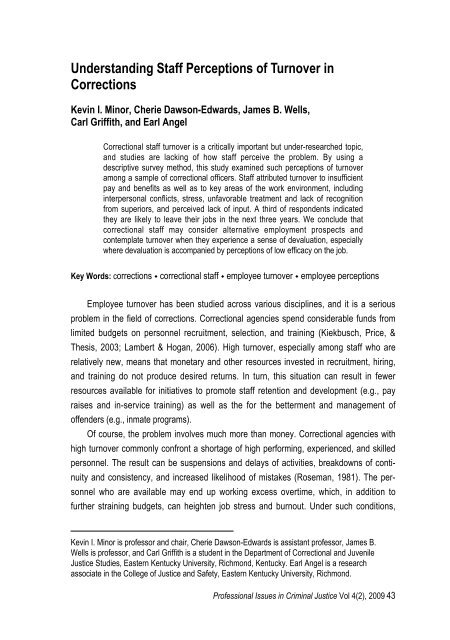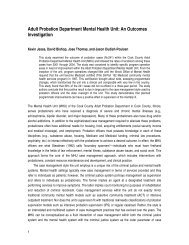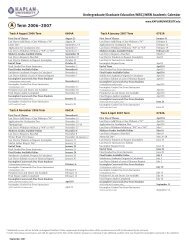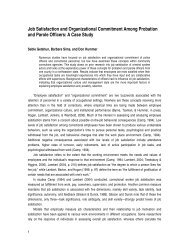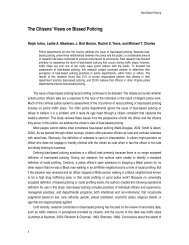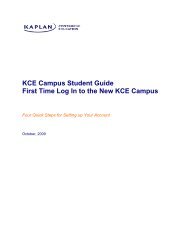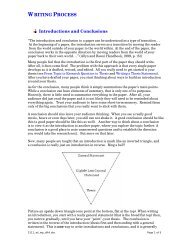Understanding Staff Perceptions of Turnover in Corrections - Kaplan ...
Understanding Staff Perceptions of Turnover in Corrections - Kaplan ...
Understanding Staff Perceptions of Turnover in Corrections - Kaplan ...
Create successful ePaper yourself
Turn your PDF publications into a flip-book with our unique Google optimized e-Paper software.
<strong>Understand<strong>in</strong>g</strong> <strong>Staff</strong> <strong>Perceptions</strong> <strong>of</strong> <strong>Turnover</strong> <strong>in</strong><br />
<strong>Corrections</strong><br />
Kev<strong>in</strong> I. M<strong>in</strong>or, Cherie Dawson-Edwards, James B. Wells,<br />
Carl Griffith, and Earl Angel<br />
Correctional staff turnover is a critically important but under-researched topic,<br />
and studies are lack<strong>in</strong>g <strong>of</strong> how staff perceive the problem. By us<strong>in</strong>g a<br />
descriptive survey method, this study exam<strong>in</strong>ed such perceptions <strong>of</strong> turnover<br />
among a sample <strong>of</strong> correctional <strong>of</strong>ficers. <strong>Staff</strong> attributed turnover to <strong>in</strong>sufficient<br />
pay and benefits as well as to key areas <strong>of</strong> the work environment, <strong>in</strong>clud<strong>in</strong>g<br />
<strong>in</strong>terpersonal conflicts, stress, unfavorable treatment and lack <strong>of</strong> recognition<br />
from superiors, and perceived lack <strong>of</strong> <strong>in</strong>put. A third <strong>of</strong> respondents <strong>in</strong>dicated<br />
they are likely to leave their jobs <strong>in</strong> the next three years. We conclude that<br />
correctional staff may consider alternative employment prospects and<br />
contemplate turnover when they experience a sense <strong>of</strong> devaluation, especially<br />
where devaluation is accompanied by perceptions <strong>of</strong> low efficacy on the job.<br />
Key Words: corrections ! correctional staff ! employee turnover ! employee perceptions<br />
Employee turnover has been studied across various discipl<strong>in</strong>es, and it is a serious<br />
problem <strong>in</strong> the field <strong>of</strong> corrections. Correctional agencies spend considerable funds from<br />
limited budgets on personnel recruitment, selection, and tra<strong>in</strong><strong>in</strong>g (Kiekbusch, Price, &<br />
Thesis, 2003; Lambert & Hogan, 2006). High turnover, especially among staff who are<br />
relatively new, means that monetary and other resources <strong>in</strong>vested <strong>in</strong> recruitment, hir<strong>in</strong>g,<br />
and tra<strong>in</strong><strong>in</strong>g do not produce desired returns. In turn, this situation can result <strong>in</strong> fewer<br />
resources available for <strong>in</strong>itiatives to promote staff retention and development (e.g., pay<br />
raises and <strong>in</strong>-service tra<strong>in</strong><strong>in</strong>g) as well as the for the betterment and management <strong>of</strong><br />
<strong>of</strong>fenders (e.g., <strong>in</strong>mate programs).<br />
Of course, the problem <strong>in</strong>volves much more than money. Correctional agencies with<br />
high turnover commonly confront a shortage <strong>of</strong> high perform<strong>in</strong>g, experienced, and skilled<br />
personnel. The result can be suspensions and delays <strong>of</strong> activities, breakdowns <strong>of</strong> conti-<br />
nuity and consistency, and <strong>in</strong>creased likelihood <strong>of</strong> mistakes (Roseman, 1981). The per-<br />
sonnel who are available may end up work<strong>in</strong>g excess overtime, which, <strong>in</strong> addition to<br />
further stra<strong>in</strong><strong>in</strong>g budgets, can heighten job stress and burnout. Under such conditions,<br />
Kev<strong>in</strong> I. M<strong>in</strong>or is pr<strong>of</strong>essor and chair, Cherie Dawson-Edwards is assistant pr<strong>of</strong>essor, James B.<br />
Wells is pr<strong>of</strong>essor, and Carl Griffith is a student <strong>in</strong> the Department <strong>of</strong> Correctional and Juvenile<br />
Justice Studies, Eastern Kentucky University, Richmond, Kentucky. Earl Angel is a research<br />
associate <strong>in</strong> the College <strong>of</strong> Justice and Safety, Eastern Kentucky University, Richmond.<br />
Pr<strong>of</strong>essional Issues <strong>in</strong> Crim<strong>in</strong>al Justice Vol 4(2), 2009 43
M<strong>in</strong>or, Dawson-Edwards, Wells, Griffith, and Angel<br />
correctional environments can grow more volatile and potentially dangerous than usual.<br />
Moreover, these circumstances can fuel public stereotypes <strong>of</strong> correctional agencies as<br />
undesirable places to work—as jobs <strong>of</strong> last resort (Stohr, Self, & Lovrich, 1992). In short,<br />
high turnover <strong>of</strong>ten feeds on itself to <strong>in</strong>tensify problems and underm<strong>in</strong>e organizational<br />
effectiveness on a number <strong>of</strong> fronts.<br />
Correctional staff turnover clearly deserves more attention than it has received <strong>in</strong> the<br />
crim<strong>in</strong>al justice literature. Furthermore, nearly all studies conducted to date have focused<br />
on the relationship <strong>of</strong> turnover to two broad categories <strong>of</strong> variables: (1) staff demographic<br />
and background pr<strong>of</strong>iles and (2) organizational and work environment variables, <strong>in</strong>clud<strong>in</strong>g<br />
work-related attitudes (see Jurik & W<strong>in</strong>n, 1987). Other than research on turnover <strong>in</strong>tentions<br />
(described below), we located few studies that have exam<strong>in</strong>ed the problem <strong>of</strong> turnover as<br />
correctional staff themselves perceive it. Yet a focus on staff perceptions complements<br />
the focus <strong>of</strong> exist<strong>in</strong>g literature on background and work environment variables. In addition,<br />
a sound argument can be made that any agency should pay careful attention to the<br />
factors its own employees see as important <strong>in</strong> promot<strong>in</strong>g and controll<strong>in</strong>g turnover. Thus,<br />
the objective <strong>of</strong> this study is to exam<strong>in</strong>e the turnover problem as correctional staff<br />
members perceive it.<br />
Literature Review<br />
Correctional staff turnover is known to be related to organizational and work environment<br />
factors. Accord<strong>in</strong>gly, there is considerable variation across correctional agencies <strong>in</strong><br />
turnover volume. While average annual turnover can be as high as 45% <strong>in</strong> corrections,<br />
the best estimate seems to be <strong>in</strong> the range <strong>of</strong> 12% to 25% (Lambert, 2001; and see<br />
McShane, Williams, Schichor, & McCla<strong>in</strong>, 1991; K. N. Wright, 1994).<br />
The literature draws two dist<strong>in</strong>ctions as regards the study <strong>of</strong> correctional staff<br />
turnover. The first is between turnover that is voluntary and <strong>in</strong>voluntary (Lambert, 2001,<br />
2006; Price & Mueller, 1986). In the case <strong>of</strong> the former, the staff member <strong>in</strong>itiates<br />
cessation <strong>of</strong> employment, while with the latter, the agency <strong>in</strong>itiates cessation (e.g., lay<strong>of</strong>fs<br />
and dismissals). Lambert suggests that this dist<strong>in</strong>ction is important because voluntary<br />
turnover is more frequent, most costly and disruptive to the organization, and the most<br />
amenable to curtailment. Indeed, dismissals are <strong>of</strong>ten <strong>in</strong> the best <strong>in</strong>terest <strong>of</strong> the organization.<br />
For this reason, researchers tend to be most <strong>in</strong>terested <strong>in</strong> voluntary turnover.<br />
A second dist<strong>in</strong>ction is that between actual turnover and turnover <strong>in</strong>tentions. Actual<br />
turnover is a behavioral construct, referr<strong>in</strong>g to an employee actually leav<strong>in</strong>g the organization.<br />
On the other hand, <strong>in</strong>tentions are a cognitive construct and refer to an employee plann<strong>in</strong>g<br />
to leave. The earlier studies <strong>of</strong> staff turnover <strong>in</strong> adult and juvenile corrections (e.g., Camp,<br />
1994; T. A. Wright, 1993) focus on actual turnover. This is sensible <strong>in</strong> that an employee<br />
44 Pr<strong>of</strong>essional Issues <strong>in</strong> Crim<strong>in</strong>al Justice Vol 4(2), 2009
<strong>Understand<strong>in</strong>g</strong> <strong>Staff</strong> <strong>Perceptions</strong> <strong>of</strong> <strong>Turnover</strong> <strong>in</strong> <strong>Corrections</strong><br />
who <strong>in</strong>dicates <strong>in</strong>tent to leave an agency might not actually end up do<strong>in</strong>g so. Alternatively,<br />
one who <strong>in</strong>dicates a plan to stay might actually leave on what amounts to a whim.<br />
However, Lambert (2006) makes a case that it is more feasible to obta<strong>in</strong> a reliable and<br />
valid measure <strong>of</strong> turnover <strong>in</strong>tent compared with actual turnover, primarily due to potential<br />
<strong>in</strong>accuracies and unavailability <strong>of</strong> agency records. He also argues that <strong>in</strong>tention is the<br />
s<strong>in</strong>gle best predictor <strong>of</strong> actual turnover behavior. More recent research has typically used<br />
measures <strong>of</strong> turnover <strong>in</strong>tent (e.g., Kiekbusch et al., 2003; Mitchell, MacKenzie, Styve, &<br />
Gover, 2000; Tipton, 2002). Still, there are questions about the extent to which <strong>in</strong>tent<br />
accurately predicts actual turnover behavior, and some have po<strong>in</strong>ted out that the time<br />
frame is important <strong>in</strong> def<strong>in</strong><strong>in</strong>g <strong>in</strong>tent because as time <strong>in</strong>creases the l<strong>in</strong>k between <strong>in</strong>tent and<br />
actual turnover weakens (see Kirschenbaum & Weisberg, 1990).<br />
As mentioned above, research on turnover and related issues <strong>in</strong> corrections has<br />
focused on <strong>in</strong>dividual background variables. Examples <strong>of</strong> these variables <strong>in</strong>clude age<br />
(Camp, 1994; Rob<strong>in</strong>son, Porpor<strong>in</strong>o, & Simourd, 1997), gender (Jurik, 1985; Tipton, 2002), race<br />
(Ford, 1995; Jacobs & Grear, 1977; Jurik & W<strong>in</strong>n, 1987; Mitchell et al., 2000), and education<br />
(Jurik, Halemba, Musheno, & Boyle, 1987; Mitchell et al., 2000). Researchers have also<br />
exam<strong>in</strong>ed variables related to the organization and work environment. Examples <strong>in</strong>clude<br />
job satisfaction (Byrd, Cochran, Silverman, & Blount, 2000; Dennis, 1998; Jurik & W<strong>in</strong>n, 1987;<br />
Udechukwu, Harr<strong>in</strong>gton, Manyak, Segal, & Graham, 2007; T. A. Wright, 1993); organizational<br />
commitment (Byrd et al., 2000; Camp, 1994; Griff<strong>in</strong> & Hepburn, 2005); and job stress (Byrd et<br />
al., 2000; Mitchell et al., 2000; Slate & Vogel, 1997).<br />
Some <strong>in</strong>vestigators outside corrections have sought to model turnover (e.g.,<br />
Kirschenbaum & Weisberg, 1990; Michaels & Spector, 1982; Mobley, Griffeth, Hand, & Megl<strong>in</strong>o,<br />
1979). These models usually conceptualize turnover <strong>in</strong> terms <strong>of</strong> the effect <strong>of</strong> moderator<br />
variables on <strong>in</strong>tentions to voluntarily term<strong>in</strong>ate employment. Lambert (2001) applied this<br />
logic to corrections and developed a model <strong>in</strong> which actual turnover behavior is seen as a<br />
direct effect <strong>of</strong> turnover <strong>in</strong>tents. In Lambert’s model, <strong>in</strong>tent is the direct outcome <strong>of</strong> perceptions<br />
<strong>of</strong> alternative employment, work related attitudes such as job satisfaction, and <strong>in</strong>dividual<br />
characteristics. Organizational commitment mediates the effect <strong>of</strong> job satisfaction on <strong>in</strong>tents.<br />
Both job satisfaction and organizational commitment, <strong>in</strong> turn, mediate the effect <strong>of</strong> personal and<br />
work environment factors.<br />
Lambert (2006) tested this model by us<strong>in</strong>g survey data collected from staff at a high<br />
security state correctional facility with a population <strong>of</strong> about 1,000 male <strong>in</strong>mates. He reported<br />
that three <strong>in</strong>dividual factors (gender, education, and tenure) and two work environment factors<br />
(organizational commitment and job satisfaction) were significant predictors <strong>of</strong> turnover<br />
<strong>in</strong>tention, with job satisfaction hav<strong>in</strong>g the strongest effect. Lambert (2008) also reported no<br />
significant relationship between job <strong>in</strong>volvement and turnover <strong>in</strong>tention. In a more recent study<br />
Pr<strong>of</strong>essional Issues <strong>in</strong> Crim<strong>in</strong>al Justice Vol 4(2), 2009 45
M<strong>in</strong>or, Dawson-Edwards, Wells, Griffith, and Angel<br />
<strong>of</strong> staff work<strong>in</strong>g <strong>in</strong> a private prison, Lambert and Hogan (2009) found the most direct<br />
predictors <strong>of</strong> turnover <strong>in</strong>tent to be age, job satisfaction, and organizational commitment.<br />
As mentioned above, someth<strong>in</strong>g miss<strong>in</strong>g from this body <strong>of</strong> literature is attention to the<br />
manner <strong>in</strong> which correctional staff members themselves account for turnover. As a<br />
process, turnover may actually beg<strong>in</strong> long before the term<strong>in</strong>ation or departure <strong>of</strong> employ-<br />
ment takes place. Referred to as psychological turnover, this may develop <strong>in</strong> an employee<br />
when certa<strong>in</strong> experiences or events occur, such as be<strong>in</strong>g overlooked for promotion,<br />
conflicts at work, major organizational restructur<strong>in</strong>g, or <strong>in</strong>sufficient pay <strong>in</strong>creases<br />
(Roseman, 1981). In addition to <strong>in</strong>stances <strong>of</strong> psychological turnover that lead ultimately to<br />
employment cessation, turnover <strong>in</strong>tent can rema<strong>in</strong> even if an employee never voluntarily<br />
severs ties to the organization. We know from psychological research that the manner <strong>in</strong><br />
which people attribute the causes <strong>of</strong> events and issues <strong>in</strong> their lives shapes what they<br />
expect to see happen and, <strong>in</strong> turn, how they behave (see Carver & Scheier, 2008; Schunk,<br />
2008). So there is good reason to consider staff perceptions <strong>of</strong> the turnover issue.<br />
There are two primary bases for correctional staff mak<strong>in</strong>g attributions about turnover<br />
<strong>in</strong> their field. The first is experiential and derives from a staff member’s own direct work<br />
history <strong>in</strong> corrections, both <strong>in</strong> the present agency and <strong>in</strong> places where she or he may have<br />
worked previously. The second basis is vicarious and derives from staff member social-<br />
ization <strong>in</strong> the employee subculture generally and, more specifically, <strong>in</strong>teractions with other<br />
correctional staff who have left their agencies or are plann<strong>in</strong>g to do so. The vicarious<br />
component consists <strong>of</strong> perceptions <strong>of</strong> why others have left the agency (or aim to do so) as<br />
well as perceptions <strong>of</strong> what those persons have accomplished by leav<strong>in</strong>g (e.g., obta<strong>in</strong><strong>in</strong>g<br />
more pay and more desirable hours from alternative employment). As such, the present<br />
study is meant to complement and extend past research on turnover <strong>in</strong>tentions by<br />
exam<strong>in</strong><strong>in</strong>g data on correctional employees’ perceptions <strong>of</strong> the staff turnover problem.<br />
Correctional Facility and Participants<br />
Method<br />
This study was conducted dur<strong>in</strong>g late 2007 and early 2008 at a medium security state<br />
prison located <strong>in</strong> a rural area. The facility’s <strong>in</strong>mate population is approximately 1,250 males. It<br />
has 285 staff members, approximately 200 <strong>of</strong> whom are correctional <strong>of</strong>ficers. While turnover<br />
data were not available for the particular facility, wider state Department <strong>of</strong> <strong>Corrections</strong><br />
(DOC) turnover was 21% for the 2006 to 2007 time period (the most recent available).<br />
The survey described below was adm<strong>in</strong>istered to a random sample <strong>of</strong> 101 correctional<br />
<strong>of</strong>ficers selected for purposes <strong>of</strong> this research. The sample was stratified to ensure proportional<br />
representation by shift, gender, race, tenure, and rank (i.e., supervisor versus l<strong>in</strong>e staff), and<br />
proportionality was achieved on these variables. The survey response rate was 88.1% (N = 89).<br />
46 Pr<strong>of</strong>essional Issues <strong>in</strong> Crim<strong>in</strong>al Justice Vol 4(2), 2009
<strong>Understand<strong>in</strong>g</strong> <strong>Staff</strong> <strong>Perceptions</strong> <strong>of</strong> <strong>Turnover</strong> <strong>in</strong> <strong>Corrections</strong><br />
The majority <strong>of</strong> respondents were male (82%) and Caucasian (97.7%), with 2.3%<br />
African American. Respondents ranged <strong>in</strong> age from 19 to 68 years, with a mean <strong>of</strong> 42<br />
years (SD = 12.3). More than half (53.9%) the respondents <strong>in</strong>dicated that their highest<br />
level <strong>of</strong> education completed was high school (either graduation or GED). More than a<br />
third (37.1%) <strong>in</strong>dicated hav<strong>in</strong>g completed some college credit without f<strong>in</strong>ish<strong>in</strong>g a degree;<br />
6.7% held an associate’s degree, and 2.2% had baccalaureate degrees.<br />
The majority <strong>of</strong> <strong>of</strong>ficers (78.7%) were l<strong>in</strong>e staff; 21.3% were supervisors. The average<br />
number <strong>of</strong> years worked <strong>in</strong> the field <strong>of</strong> corrections was 7.5 (SD = 6.27). The average<br />
number <strong>of</strong> years employed <strong>in</strong> the particular DOC was 7.0 (SD = 6.02), while the average<br />
years worked at the facility were the research was conducted was 6.8 (SD = 6.05). The<br />
average start<strong>in</strong>g salary for a correctional <strong>of</strong>ficer <strong>in</strong> the DOC for 2005 (the most recent<br />
available) was $25,565.<br />
Survey Instrument<br />
The survey <strong>in</strong>strument used <strong>in</strong> this study had five parts. The first part asked staff to provide an<br />
open-ended description <strong>of</strong> the top three reasons they believe correctional <strong>of</strong>ficers leave the<br />
DOC with<strong>in</strong> three years <strong>of</strong> be<strong>in</strong>g hired. Part two asked staff to rate the importance <strong>of</strong> 15 factors<br />
<strong>in</strong> promot<strong>in</strong>g <strong>of</strong>ficer turnover. Rat<strong>in</strong>gs were made on a five-po<strong>in</strong>t Likert scale, rang<strong>in</strong>g from very<br />
unimportant (1) to very important (5). The factors were selected based on the literature<br />
review and on the basis <strong>of</strong> one <strong>of</strong> the author’s 16 years <strong>of</strong> experience work<strong>in</strong>g <strong>in</strong> the DOC.<br />
Part three <strong>of</strong> the survey was meant to assess participants’ turnover <strong>in</strong>tentions. Participants<br />
were asked to <strong>in</strong>dicate (from the follow<strong>in</strong>g options) the time frame <strong>in</strong> which they <strong>in</strong>tend to leave<br />
the DOC and <strong>in</strong>structed to select only one option: 6 months, 12 months, 3 years, 5 years, 10<br />
years, 15 years, or 20 years or more. Subsequently, participants were asked to provide an<br />
open-ended response describ<strong>in</strong>g the reason(s) for leav<strong>in</strong>g <strong>in</strong> the <strong>in</strong>dicated time frame, start<strong>in</strong>g<br />
with the most important reason.<br />
The fourth part <strong>of</strong> the survey was an open-ended item ask<strong>in</strong>g participants to describe<br />
the most important change(s) the DOC could implement to reduce staff turnover. The f<strong>in</strong>al<br />
part solicited the staff demographic and background <strong>in</strong>formation described above.<br />
Survey participation was voluntary and anonymous. Follow<strong>in</strong>g distribution to staff,<br />
surveys were returned <strong>in</strong> sealed envelopes.<br />
Survey Part 1<br />
Results<br />
Low pay was overwhelm<strong>in</strong>gly the major reason staff gave to account for turnover. Nearly<br />
97% <strong>of</strong> respondents cited pay as one <strong>of</strong> the top three reasons new staff leave the DOC<br />
Pr<strong>of</strong>essional Issues <strong>in</strong> Crim<strong>in</strong>al Justice Vol 4(2), 2009 47
M<strong>in</strong>or, Dawson-Edwards, Wells, Griffith, and Angel<br />
with<strong>in</strong> the first three years <strong>of</strong> be<strong>in</strong>g hired. Additionally, 37% cited <strong>in</strong>surance or benefits as<br />
a reason. More than 21% mentioned the need to f<strong>in</strong>d a “better” job or one closer to home.<br />
However, not all reasons given related primarily to economics. <strong>Staff</strong> also cited key<br />
features <strong>of</strong> the work environment. For example, 29.2% listed <strong>in</strong>terpersonal conflicts with<br />
coworkers or supervisors as reasons for staff departures, and 28.1% cited stress or the<br />
poor nature <strong>of</strong> the work environment. More than 20% made reference to unequal or<br />
unfavorable treatment <strong>of</strong> staff from supervisors.<br />
Lesser proportions <strong>of</strong> respondents attributed turnover to other factors. Almost 17%<br />
referenced the nature <strong>of</strong> the work schedule (i.e., shifts and hours worked). Nearly 16% <strong>of</strong><br />
respondents said that staff leave due to concerns or fears over personal safety. More than<br />
11% stated that employees who leave do so when they learn the nature <strong>of</strong> the job is not<br />
what they expected. Other factors cited <strong>in</strong>cluded staff shortages (9% <strong>of</strong> respondents) and<br />
poor tra<strong>in</strong><strong>in</strong>g (7.9%).<br />
Table 1. Perceived Importance <strong>of</strong> Factors Potentially Contribut<strong>in</strong>g to <strong>Turnover</strong> (N = 89)<br />
48 Pr<strong>of</strong>essional Issues <strong>in</strong> Crim<strong>in</strong>al Justice Vol 4(2), 2009<br />
Factor Mean SD<br />
Inadequate pay scales 4.82 0.44<br />
Concerns over personal safety 4.30 0.79<br />
Concerns over <strong>in</strong>stitutional security 4.26 0.76<br />
Officers not know<strong>in</strong>g what their supervisors expect 4.09 0.83<br />
Officers not believ<strong>in</strong>g that senior management understands<br />
problems faced on the job<br />
4.43 0.74<br />
Problems with coworkers 3.91 1.05<br />
Problems with <strong>in</strong>mates 3.84 1.03<br />
Officers feel<strong>in</strong>g they lack say over matters that most affect them 4.45 0.64<br />
Lack <strong>of</strong> loyalty to the <strong>in</strong>stitution 4.01 0.95<br />
Lack <strong>of</strong> satisfaction with the nature <strong>of</strong> the work 4.06 0.84<br />
Stressful work environment 4.61 0.67<br />
Inadequate tra<strong>in</strong><strong>in</strong>g 4.13 0.88<br />
Feel<strong>in</strong>g that the job is dead-end with few opportunities to advance 3.96 0.95<br />
<strong>Perceptions</strong> <strong>of</strong> better employment opportunities elsewhere 4.49 0.74<br />
Job keeps them away from their family too much 3.66 1.11<br />
Survey Part 2<br />
Recall that the second part <strong>of</strong> the survey solicited staff rat<strong>in</strong>gs <strong>of</strong> the importance <strong>of</strong> various<br />
factors <strong>in</strong> promot<strong>in</strong>g <strong>of</strong>ficer turnover. Rat<strong>in</strong>gs ranged from 1 (least important) to 5 (most<br />
important). Table 1 presents descriptive data.
<strong>Understand<strong>in</strong>g</strong> <strong>Staff</strong> <strong>Perceptions</strong> <strong>of</strong> <strong>Turnover</strong> <strong>in</strong> <strong>Corrections</strong><br />
As the table shows, no items had mean rat<strong>in</strong>gs below 3.66. Items with the highest<br />
mean rat<strong>in</strong>gs perta<strong>in</strong>ed to pay scales, work stress, perceptions <strong>of</strong> alternative employment,<br />
perceived lack <strong>of</strong> say over matters affect<strong>in</strong>g staff, not believ<strong>in</strong>g managers understand the<br />
problems <strong>of</strong>ficers face, and the <strong>in</strong>terrelated issues <strong>of</strong> personal safety concerns and<br />
concerns over <strong>in</strong>stitutional security. Other items with relatively high mean rat<strong>in</strong>gs <strong>in</strong>clude<br />
the <strong>in</strong>adequacy <strong>of</strong> tra<strong>in</strong><strong>in</strong>g, <strong>of</strong>ficers feel<strong>in</strong>g that they do not know what their supervisors<br />
expect, dissatisfaction with the nature <strong>of</strong> the work, and lack <strong>of</strong> loyalty to the <strong>in</strong>stitution.<br />
Multiple t-tests were performed to determ<strong>in</strong>e the extent to which staff rat<strong>in</strong>gs <strong>of</strong> the<br />
factors <strong>in</strong> Table 1 varied by different staff categories based on demographics and back-<br />
grounds. Only one test yielded significant results. The mean rat<strong>in</strong>g (5.00, SD = .000)<br />
assigned to <strong>in</strong>adequate pay by women was significantly higher than the rat<strong>in</strong>g (4.78,<br />
SD = .479) assigned by men, t (72) = 3.91, p = .000, 2-tailed.<br />
Correlations were computed to study the relationship between rat<strong>in</strong>gs and cont<strong>in</strong>uous<br />
staff demographic variables. Four significant relationships were found, two <strong>in</strong>volv<strong>in</strong>g<br />
education and two <strong>in</strong>volv<strong>in</strong>g age. Compared with staff with higher education levels, those<br />
with less education rated “concerns over <strong>in</strong>stitutional security” as a more important cause<br />
<strong>of</strong> turnover (r = -.27, p = .01). Similarly, staff with less education had higher rat<strong>in</strong>gs <strong>of</strong> the<br />
factor “<strong>of</strong>ficers not know<strong>in</strong>g what their supervisors except” (r = -.26, p = .02). Rat<strong>in</strong>gs on<br />
this same factor decreased as age <strong>in</strong>creased (r = -.23, p = .04). F<strong>in</strong>ally, rat<strong>in</strong>gs on the<br />
factor “<strong>of</strong>ficers feel<strong>in</strong>g they lack say over matters that most affect them” decl<strong>in</strong>ed with<br />
<strong>in</strong>creas<strong>in</strong>g age (r = -.24, p = .03).<br />
Survey Part 3<br />
Table 2 shows the proportion <strong>of</strong> respondents <strong>in</strong>dicat<strong>in</strong>g that they are likely to leave<br />
the DOC with<strong>in</strong> the various time frames. As the table reveals, more than 20% <strong>of</strong> the<br />
respondents said they were likely to leave <strong>in</strong> the com<strong>in</strong>g three years, and 11.5% <strong>in</strong>dicated<br />
a likelihood to leave <strong>in</strong> the com<strong>in</strong>g year. On the other hand, more than 55% selected 10<br />
years or longer as the time frame.<br />
Given that more than half <strong>of</strong> the staff said they plan to stay with the DOC at least<br />
another decade, it is not surpris<strong>in</strong>g that the most commonly cited reason for departure<br />
(58.4% <strong>of</strong> respondents) was retirement. (These DOC staff members are eligible to retire<br />
after 20 years <strong>of</strong> service.) But other reasons were also given. Nearly 15% expressed a<br />
desire to f<strong>in</strong>d a different or better job. Similarly, 11.2% cited poor pay as a reason for their<br />
turnover <strong>in</strong>tentions. Other explanations <strong>in</strong>cluded stress (4.5%), safety concerns (3.4%),<br />
lack <strong>of</strong> opportunities for promotion, (3.4%), and the way staff feel they are treated (3.4%);<br />
the latter category <strong>in</strong>cluded mention <strong>of</strong> poor or unequal treatment and lack <strong>of</strong> recognition.<br />
Pr<strong>of</strong>essional Issues <strong>in</strong> Crim<strong>in</strong>al Justice Vol 4(2), 2009 49
M<strong>in</strong>or, Dawson-Edwards, Wells, Griffith, and Angel<br />
Table 2. Percentage <strong>of</strong> Respondents Likely to Leave DOC <strong>in</strong><br />
Specified Time Periods (N = 87) a<br />
Time Period N %<br />
6 months 1 1.1<br />
1 year 10 11.5<br />
3 years 18 20.7<br />
5 years 10 11.5<br />
10 years 17 19.5<br />
15 years 9 10.3<br />
20 years or more 22 25.3<br />
a Two study participants did not answer this question.<br />
Survey Part 4<br />
The respondents identified a number <strong>of</strong> important changes they believed the DOC might<br />
make to reduce staff turnover. Improved pay was by far the most commonly cited change<br />
(89.9% <strong>of</strong> respondents). Similarly, 29.2% made reference to improved <strong>in</strong>surance and benefits.<br />
Almost 32% described the need for improved treatment and recognition <strong>of</strong> <strong>of</strong>ficers.<br />
Other changes were mentioned with less frequency. These <strong>in</strong>cluded improved<br />
communication and teamwork (9%), hir<strong>in</strong>g <strong>of</strong> additional staff (5.6%), improved hir<strong>in</strong>g<br />
practices (3.4%), improvements to work environment safety (3.4%), provision <strong>of</strong> better<br />
equipment (3.4%), improved opportunities for promotion (2.2%), and better public<br />
perceptions <strong>of</strong> corrections (1.1%).<br />
Discussion and Conclusion<br />
A high level <strong>of</strong> correctional staff turnover can feed <strong>of</strong>f itself to exacerbate problems, impair<br />
organizational effectiveness, and promote even more turnover. We have suggested that<br />
any correctional agency can benefit by identify<strong>in</strong>g and attend<strong>in</strong>g to factors its employees<br />
perceive as important <strong>in</strong> promot<strong>in</strong>g and controll<strong>in</strong>g turnover. These employees are<br />
uniquely positioned to understand the problem due to their own direct experiences as well<br />
as their <strong>in</strong>teractions with and observations <strong>of</strong> other employees.<br />
The causal attributions people make about issues they encounter affect their expectations<br />
and behaviors (Carver & Scheier, 2008; Schunk, 2008). It is reasonable to believe that<br />
employees <strong>of</strong> all organizations have ideas about causes <strong>of</strong> organizational problems generally<br />
and, <strong>in</strong> particular, about why people might leave an organization. Direct and vicarious<br />
experiences <strong>in</strong> an organization help establish and confirm (or disconfirm) employees’<br />
attributions regard<strong>in</strong>g organizational problems, and <strong>in</strong> this ongo<strong>in</strong>g manner, employee<br />
attributions concern<strong>in</strong>g turnover could affect turnover <strong>in</strong>tents and ultimately behavior.<br />
50 Pr<strong>of</strong>essional Issues <strong>in</strong> Crim<strong>in</strong>al Justice Vol 4(2), 2009
<strong>Understand<strong>in</strong>g</strong> <strong>Staff</strong> <strong>Perceptions</strong> <strong>of</strong> <strong>Turnover</strong> <strong>in</strong> <strong>Corrections</strong><br />
In many respects, the participants <strong>in</strong> this study mirrored the traditional prototype <strong>of</strong><br />
correctional <strong>of</strong>ficers. For <strong>in</strong>stance, they were employed <strong>in</strong> a rural geographical area <strong>in</strong> a<br />
medium security male <strong>in</strong>stitution. They were predom<strong>in</strong>antly male, Caucasian, middle<br />
aged, lack<strong>in</strong>g a college degree, and employed <strong>in</strong> l<strong>in</strong>e positions. Almost 21% <strong>in</strong>dicated they<br />
were likely to leave the DOC over the next three years, and 11.5% said they were likely to<br />
leave with<strong>in</strong> a year. This one-year <strong>in</strong>tent figure approaches the lower end <strong>of</strong> the 12 to 25%<br />
actual turnover range referenced <strong>in</strong> the literature (Lambert, 2001) but is only about half<br />
the most recently available (2006–2007) DOC-wide actual figure <strong>of</strong> 21%. By the same<br />
token, the facility seems to have a relatively stable core <strong>of</strong> staff plann<strong>in</strong>g to retire from the<br />
DOC. More than 55% <strong>of</strong> the respondents said they planned to stay with the DOC for 10<br />
years or longer, and more than a quarter <strong>in</strong>tended to stay 20 years or more. On average,<br />
respondents had already worked at the facility for nearly 7 years. So there is evidence <strong>of</strong><br />
core stability amid higher than desired levels <strong>of</strong> turnover.<br />
It is worth not<strong>in</strong>g that there was m<strong>in</strong>imal variation across subgroups <strong>of</strong> staff <strong>in</strong> their<br />
perceptions <strong>of</strong> reasons for turnover. From the standpo<strong>in</strong>t <strong>of</strong> statistical significance, women<br />
rated <strong>in</strong>adequate pay at a higher level <strong>of</strong> importance than men, but the mean difference <strong>in</strong><br />
rat<strong>in</strong>gs was too small (0.22 po<strong>in</strong>ts) to be <strong>of</strong> much practical significance. There were also a<br />
few significant correlations by education and age, but, all <strong>in</strong> all, there was a strong pattern<br />
<strong>of</strong> homogeneity <strong>in</strong> staff perceptions. Perhaps most important, there were no significant<br />
differences <strong>in</strong> rat<strong>in</strong>gs by employee rank. L<strong>in</strong>e <strong>of</strong>ficers and supervisors provided similar<br />
rat<strong>in</strong>gs. The same holds for tenure <strong>in</strong> the field <strong>of</strong> corrections generally, tenure with the<br />
DOC, and tenure at the facility. In this study, therefore, there is no evidence that turnover<br />
attributions are a function <strong>of</strong> rank or tenure.<br />
People who have spent time employed <strong>in</strong> the field know that corrections work can be<br />
demand<strong>in</strong>g, stressful, and potentially dangerous. It is too frequently characterized by low<br />
pay and a dearth <strong>of</strong> other rewards, such as status and recognition from the public,<br />
supervisors, and other parties. Such as they exist, rewards are largely <strong>in</strong>tr<strong>in</strong>sic and come<br />
<strong>in</strong> the form <strong>of</strong> employees believ<strong>in</strong>g they are perform<strong>in</strong>g the job effectively, both <strong>in</strong>dividually<br />
and as part <strong>of</strong> the organization (i.e., a sense <strong>of</strong> efficacy). In short, the job is very important<br />
but, <strong>in</strong> many respects, thankless. Intr<strong>in</strong>sic rewards, such as believ<strong>in</strong>g that one is able to<br />
help make a positive difference, become paramount almost by default.<br />
The data from this study support this portrayal <strong>of</strong> correctional work. Specifically, the<br />
respondents perceived staff turnover as result<strong>in</strong>g from <strong>in</strong>sufficient pay and benefits as well<br />
as from the availability <strong>of</strong> alternative employment. Almost all respondents listed low pay<br />
as one <strong>of</strong> the top three reasons for turnover among new recruits. Pay received the highest<br />
mean rat<strong>in</strong>g <strong>of</strong> any item <strong>in</strong> Part 2 <strong>of</strong> the survey, and almost 90% <strong>of</strong> respondents said the<br />
DOC could reduce turnover by improv<strong>in</strong>g pay. However, only 11.2% <strong>of</strong> respondents cited<br />
Pr<strong>of</strong>essional Issues <strong>in</strong> Crim<strong>in</strong>al Justice Vol 4(2), 2009 51
M<strong>in</strong>or, Dawson-Edwards, Wells, Griffith, and Angel<br />
poor pay as a reason they personally <strong>in</strong>tended to leave the DOC. Clearly, then, poor pay<br />
received more weight <strong>in</strong> account<strong>in</strong>g for the turnover <strong>of</strong> coworkers than for expla<strong>in</strong><strong>in</strong>g<br />
employees’ own <strong>in</strong>tentions. Indeed, other researchers have not found pay and benefits to<br />
affect turnover significantly (e.g., Camp, 1994; Lambert, 2006).<br />
However, perceptions <strong>of</strong> alternative employment may be a different matter entirely.<br />
Recall that <strong>in</strong> his model, Lambert (2001) hypothesized that turnover <strong>in</strong>tentions were a<br />
direct outcome <strong>of</strong> perceptions <strong>of</strong> alternative employment availability. And, <strong>in</strong> fact,<br />
Kiekbusch et al. (2003) reported that perceptions <strong>of</strong> the economy and outside job<br />
opportunities were predictive <strong>of</strong> turnover among jail employees. By def<strong>in</strong>ition, though,<br />
perceptions <strong>of</strong> alternative employment are fluid and cont<strong>in</strong>gent on the time frame a study<br />
considers. Interest<strong>in</strong>gly, the data for this study were collected dur<strong>in</strong>g the latter part <strong>of</strong> 2007<br />
and early <strong>in</strong> 2008, a few months before the major downturn <strong>in</strong> the United States economy<br />
that became manifest <strong>in</strong> mid 2008 with the fall <strong>of</strong> the hous<strong>in</strong>g market, soar<strong>in</strong>g fuel prices,<br />
and the ensu<strong>in</strong>g demise <strong>of</strong> banks, securities, and major corporations. Along with these<br />
developments, unemployment became so problematic that massive job creation has been<br />
made central to the Obama Adm<strong>in</strong>istration’s economic recovery plan. These develop-<br />
ments are bound to <strong>in</strong>fluence the role <strong>of</strong> perceived alternative employment opportunities<br />
<strong>in</strong> affect<strong>in</strong>g turnover. At present (first quarter <strong>of</strong> 2009), fewer staff <strong>in</strong> the DOC studied<br />
(relative to the number surveyed <strong>in</strong> late 2007 and early 2008) might see alternative<br />
employment prospects as plentiful or desirable, but this could change with success from<br />
job creation <strong>in</strong>itiatives and added competition for workers.<br />
Some <strong>of</strong> the less tangible but no less important work environment factors that have<br />
been l<strong>in</strong>ked to turnover <strong>in</strong> past research (e.g., Byrd et al., 2000; Lambert, 2006; Mitchell et<br />
al., 2000) also emerged <strong>in</strong> this study. A sizeable proportion <strong>of</strong> respondents (nearly 30%)<br />
identified <strong>in</strong>terpersonal conflicts as one <strong>of</strong> the top three reasons for employee turnover,<br />
almost as many cited stress, and more than 20% referenced unfavorable treatment from<br />
supervisors. Similarly, also receiv<strong>in</strong>g high rat<strong>in</strong>gs were the items <strong>in</strong> Part 2 deal<strong>in</strong>g with <strong>of</strong>ficers<br />
feel<strong>in</strong>g that management does not understand problems faced on the job and <strong>of</strong>ficers feel<strong>in</strong>g<br />
they lack say over matters affect<strong>in</strong>g them. Nearly 32% <strong>of</strong> respondents identified better<br />
treatment and recognition <strong>of</strong> <strong>of</strong>ficers as a means for the DOC to control turnover.<br />
Some <strong>of</strong> the perceptions just described (i.e., unfavorable treatment and lack <strong>of</strong><br />
recognition from superiors, feel<strong>in</strong>g misunderstood, and sens<strong>in</strong>g a lack <strong>of</strong> say over matters<br />
directly affect<strong>in</strong>g <strong>of</strong>ficers), when comb<strong>in</strong>ed with the perceptions <strong>of</strong> <strong>in</strong>sufficient pay and<br />
benefits mentioned above, pa<strong>in</strong>t a portrait <strong>of</strong> <strong>of</strong>ficers perceiv<strong>in</strong>g themselves as devalued<br />
for what they do. It is reasonable to suppose that people who perform work that is<br />
demand<strong>in</strong>g, stressful, potentially dangerous, and yet very necessary to society need to<br />
sense their contributions and sacrifices are valued. However, this is unlikely to the extent<br />
52 Pr<strong>of</strong>essional Issues <strong>in</strong> Crim<strong>in</strong>al Justice Vol 4(2), 2009
<strong>Understand<strong>in</strong>g</strong> <strong>Staff</strong> <strong>Perceptions</strong> <strong>of</strong> <strong>Turnover</strong> <strong>in</strong> <strong>Corrections</strong><br />
employees believe that their pay and benefits are <strong>in</strong>adequate, they are not sufficiently<br />
recognized <strong>in</strong> other ways, they are poorly treated, and their <strong>in</strong>put is nonexistent or<br />
disregarded. The outcome is likely to be a converse sense <strong>of</strong> devaluation.<br />
The devaluation construct underscores the po<strong>in</strong>t made earlier about correctional work<br />
<strong>in</strong>volv<strong>in</strong>g a paucity <strong>of</strong> external rewards, such that motivation to cont<strong>in</strong>ue <strong>in</strong> the field<br />
becomes heavily reliant upon <strong>in</strong>tr<strong>in</strong>sic factors. One <strong>of</strong> the foremost <strong>of</strong> these factors may<br />
be <strong>in</strong>dividual and collective efficacy (Bandura, 1997, 2001). Unfortunately data to address<br />
the issue are lack<strong>in</strong>g from the present study, but a tenable hypothesis is that <strong>in</strong>creases <strong>in</strong><br />
both turnover <strong>in</strong>tentions and behavior are especially probable when perceptions <strong>of</strong><br />
devaluation <strong>of</strong> the k<strong>in</strong>d this research uncovered conjo<strong>in</strong> with perceptions <strong>of</strong> low efficacy<br />
among staff. When this occurs, there is noth<strong>in</strong>g to b<strong>in</strong>d the employee to the agency,<br />
except perhaps the need for a paycheck and benefits <strong>of</strong> some form; ergo, the<br />
attractiveness <strong>of</strong> alternative employment.<br />
Low efficacy perceptions could arise from any number <strong>of</strong> conceivable sources not<br />
assessed <strong>in</strong> this study (e.g., jurisdictional policy changes, physical limitations developed<br />
by an employee, absence <strong>of</strong> resources for <strong>in</strong>mate programm<strong>in</strong>g, political dynamics, etc.).<br />
However, an important potential source that did surface <strong>in</strong> this study (as a factor important<br />
<strong>in</strong> promot<strong>in</strong>g turnover) <strong>in</strong>volves conflicts with coworkers or supervisors. A work<br />
environment riddled with conflict among staff is hardly one where staff are likely to believe<br />
they are advanc<strong>in</strong>g organizational goals <strong>in</strong> an optimal way. A further source <strong>of</strong> low efficacy<br />
could be high levels <strong>of</strong> employee turnover among coworkers. As po<strong>in</strong>ted out earlier, high<br />
turnover consumes resources that could be used to promote effectiveness <strong>in</strong> other areas<br />
<strong>of</strong> an organization. It can lead to breakdowns <strong>in</strong> cont<strong>in</strong>uity, job stress, burnout, and<br />
mistakes. In short, staff conflict and turnover are not conducive to a sense <strong>of</strong> efficacy<br />
among people who rema<strong>in</strong> <strong>in</strong> the organization.<br />
The f<strong>in</strong>d<strong>in</strong>gs <strong>of</strong> this study imply the need for cont<strong>in</strong>ued efforts to improve the pay and<br />
benefits <strong>of</strong> correctional <strong>of</strong>ficers, at least <strong>in</strong> the facility studied and <strong>in</strong> similar ones. It would<br />
be easy to m<strong>in</strong>imize the importance <strong>of</strong> such efforts <strong>in</strong> view <strong>of</strong>: (a) the f<strong>in</strong>d<strong>in</strong>g that more<br />
employees see <strong>in</strong>adequate pay and benefits as important <strong>in</strong> account<strong>in</strong>g for turnover<br />
among other staff than <strong>in</strong> account<strong>in</strong>g for their own personal turnover <strong>in</strong>tents and (b) other<br />
research show<strong>in</strong>g that pay and benefits are not significantly related to turnover (see<br />
Lambert, 2006). Still, the presence <strong>of</strong> a substantial proportion <strong>of</strong> staff who believe poor<br />
pay and benefits are among the top reasons their coworkers leave the organization is<br />
likely to detract from morale and organizational effectiveness. Also, it seems clear that<br />
efforts to improve pay and benefits are important for recruit<strong>in</strong>g top quality staff to the field.<br />
Additionally, <strong>in</strong>adequate pay and benefits constitute one, but certa<strong>in</strong>ly not the only<br />
and possibly not even the most important, basis for employees feel<strong>in</strong>g devalued for their<br />
Pr<strong>of</strong>essional Issues <strong>in</strong> Crim<strong>in</strong>al Justice Vol 4(2), 2009 53
M<strong>in</strong>or, Dawson-Edwards, Wells, Griffith, and Angel<br />
work. Concerns over pay and benefits may become <strong>in</strong>tensified to the extent that these are<br />
part <strong>of</strong> a larger composite <strong>of</strong> factors promot<strong>in</strong>g a sense <strong>of</strong> devaluation. Examples <strong>of</strong> other<br />
factors this study identified <strong>in</strong>clude perceptions <strong>of</strong> unfavorable treatment, lack <strong>of</strong><br />
understand<strong>in</strong>g and recognition, and lack <strong>of</strong> opportunity for <strong>in</strong>put. This implies the need for<br />
<strong>in</strong>itiatives other than improved pay and benefits to make staff feel more valued.<br />
For <strong>in</strong>stance, some jurisdictions have <strong>in</strong>stituted periodic recognitions for <strong>of</strong>ficers<br />
exhibit<strong>in</strong>g excellent performance. However, <strong>in</strong>itiatives need not be so formal or<br />
competitive to be effective. An adm<strong>in</strong>istrator who practices “management by walk<strong>in</strong>g<br />
around,” takes time to <strong>in</strong>form staff that they are valued and appreciated, and endeavors to<br />
establish rapport with subord<strong>in</strong>ates can accomplish a great deal <strong>in</strong> this regard.<br />
In terms <strong>of</strong> opportunities for staff <strong>in</strong>put, there are various ways to <strong>in</strong>crease<br />
participation <strong>in</strong> decision mak<strong>in</strong>g and promote greater staff autonomy. Interest<strong>in</strong>gly<br />
enough, such <strong>in</strong>itiatives have also been demonstrated to be associated with reductions <strong>in</strong><br />
job stress (Auerbach, Quick, & Pegg, 2003; Dowden & Tellier, 2004; Wright, Saylor,<br />
Gilman, & Camp, 1997), another major factor that staff <strong>in</strong> this study saw as contribut<strong>in</strong>g to<br />
turnover. And <strong>in</strong> fact, Slate and Vogel (1997) reported that thoughts about quitt<strong>in</strong>g among<br />
correctional staff are l<strong>in</strong>ked with perceptions <strong>of</strong> an organizational atmosphere that is<br />
negative toward staff participation <strong>in</strong> decision mak<strong>in</strong>g.<br />
<strong>Staff</strong> members usually have much knowledge <strong>of</strong> problems and issues faced at their<br />
facilities. A more decentralized, participative approach to <strong>in</strong>stitutional management that<br />
makes use <strong>of</strong> advisory groups and decision-mak<strong>in</strong>g bodies compris<strong>in</strong>g staff can draw<br />
upon this knowledge. The po<strong>in</strong>t is to m<strong>in</strong>imize l<strong>in</strong>e staff detachment from management<br />
and managerial issues. Approaches <strong>of</strong> this nature could also promote a heightened sense<br />
<strong>of</strong> efficacy among staff (cf. Wells, M<strong>in</strong>or, Angel, Matz, & Amato, 2009).<br />
Future research seems warranted <strong>in</strong>to staff perceptions surround<strong>in</strong>g the turnover<br />
problem. Data for the present study came from a s<strong>in</strong>gle facility, the number <strong>of</strong> cases was<br />
limited, and the data obta<strong>in</strong>ed were largely descriptive <strong>in</strong> nature. Future <strong>in</strong>vestigations could use<br />
larger samples with greater variation <strong>in</strong> staff demographics and facilities. While descriptive<br />
studies such as this are valuable for generat<strong>in</strong>g hypotheses, data collection <strong>in</strong>struments could<br />
be redesigned to allow for more <strong>in</strong>ferential analyses and multivariate model<strong>in</strong>g.<br />
This study raises the need for additional <strong>in</strong>quiry <strong>in</strong>to possible discrepancies between<br />
why employees believe their coworkers exhibit turnover and why they personally con-<br />
template leav<strong>in</strong>g. Likewise, the construct <strong>of</strong> devaluation this study developed should<br />
receive more attention, specifically attention to further establish<strong>in</strong>g construct validity and<br />
exam<strong>in</strong><strong>in</strong>g the potential sources. F<strong>in</strong>ally, future <strong>in</strong>vestigations could explore the <strong>in</strong>teraction<br />
this study proposed between perceptions <strong>of</strong> devaluation and low perceptions <strong>of</strong> efficacy<br />
as a reason for staff opt<strong>in</strong>g to explore alternative employment. It may turn out that <strong>in</strong> a<br />
54 Pr<strong>of</strong>essional Issues <strong>in</strong> Crim<strong>in</strong>al Justice Vol 4(2), 2009
<strong>Understand<strong>in</strong>g</strong> <strong>Staff</strong> <strong>Perceptions</strong> <strong>of</strong> <strong>Turnover</strong> <strong>in</strong> <strong>Corrections</strong><br />
model such as the one Lambert (2001) proposed, perceptions <strong>of</strong> alternative employment<br />
mediate the effects <strong>of</strong> devaluation and low perceptions <strong>of</strong> efficacy on turnover <strong>in</strong>tents. If<br />
research was to establish the importance <strong>of</strong> such a connection <strong>in</strong> prompt<strong>in</strong>g decisions to<br />
leave, efforts designed to promote a greater sense <strong>of</strong> valuation among staff could be<br />
<strong>in</strong>tegrated with <strong>in</strong>itiatives to foster greater efficacy and overcome bureaucratic and political<br />
barriers to staff sens<strong>in</strong>g they are accomplish<strong>in</strong>g someth<strong>in</strong>g worthwhile <strong>in</strong> their work with<br />
<strong>of</strong>fenders. In short, the subject <strong>of</strong> correctional staff turnover cont<strong>in</strong>ues to provide fertile<br />
ground for theory and research.<br />
References<br />
Auerbach, S. M., Quick, B. G., & Pegg, P. O. (2003). General job stress and job-specific<br />
stress <strong>in</strong> juvenile correctional <strong>of</strong>ficers. Journal <strong>of</strong> Crim<strong>in</strong>al Justice, 31, 25–36.<br />
Bandura, A. (1997). Self-efficacy: The exercise <strong>of</strong> control. New York: Freeman.<br />
Bandura, A. (2001). Social cognitive theory: An agentic perspective. Annual Review <strong>of</strong><br />
Psychology, 52, 1–26.<br />
Byrd, T. G., Cochran, J. K., Silverman, I. J., & Blount, W. R. (2000). Beh<strong>in</strong>d bars: An<br />
assessment <strong>of</strong> the effects <strong>of</strong> job satisfaction, job-related stress, and anxiety on jail<br />
employees’ <strong>in</strong>cl<strong>in</strong>ations to quit. Journal <strong>of</strong> Crime and Justice, 23, 69–93.<br />
Camp, S. D. (1994). Assess<strong>in</strong>g the effects <strong>of</strong> organizational commitment and job<br />
satisfaction on turnover: An event history approach. The Prison Journal, 74, 279–305.<br />
Carver, C. C., & Scheier, M. F. (2008). Perspectives on personality (6 th ed.). Boston, MA:<br />
Allyn and Bacon.<br />
Dennis, G. L. (1998). Here today, gone tomorrow: How management style affects job<br />
satisfaction and, <strong>in</strong> turn, employee turnover. <strong>Corrections</strong> Today, 60, 96–102.<br />
Dowden, C., & Tellier, C. (2004). Predict<strong>in</strong>g work-related stress <strong>in</strong> correctional <strong>of</strong>ficers: A<br />
meta-analysis. Journal <strong>of</strong> Crim<strong>in</strong>al Justice, 32, 31–47.<br />
Ford, M. (1995). Job performance and job tenure <strong>of</strong> jailers. In N. A. Jackson (Ed),<br />
Contemporary issues <strong>in</strong> crim<strong>in</strong>al justice: Shap<strong>in</strong>g tomorrow’s system (pp. 243–257).<br />
New York: McGraw-Hill.<br />
Griff<strong>in</strong>, M. L., & Hepburn, J. R. (2005). Side-bets and reciprocity as determ<strong>in</strong>ants <strong>of</strong><br />
organizational commitment among correctional <strong>of</strong>ficers. Journal <strong>of</strong> Crim<strong>in</strong>al Justice,<br />
33, 611–625.<br />
Pr<strong>of</strong>essional Issues <strong>in</strong> Crim<strong>in</strong>al Justice Vol 4(2), 2009 55
M<strong>in</strong>or, Dawson-Edwards, Wells, Griffith, and Angel<br />
Jacobs, J. B., & Grear, M. P. (1977). Drop outs and rejects: An analysis <strong>of</strong> the prison<br />
guard’s revolv<strong>in</strong>g door. Crim<strong>in</strong>al Justice Review, 2, 57–70.<br />
Jurik, N. C. (1985). An <strong>of</strong>ficer and a lady: Organizational barriers to women work<strong>in</strong>g as<br />
correctional <strong>of</strong>ficers <strong>in</strong> men’s prisons. Social Problems, 32, 375–388.<br />
Jurik, N. C., Halemba, G. J., Musheno, M. C., & Boyle, B. (1987). Education atta<strong>in</strong>ment,<br />
job satisfaction, and the pr<strong>of</strong>essionalism <strong>of</strong> correctional <strong>of</strong>ficers. Work and<br />
Occupations, 14, 106–125.<br />
Jurik, N. C., & W<strong>in</strong>n, R. (1987). Describ<strong>in</strong>g correctional-security dropout and rejects: An<br />
<strong>in</strong>dividual or organizational pr<strong>of</strong>ile? Crim<strong>in</strong>al Justice and Behavior, 14, 5–25.<br />
Kiekbusch, R., Price, W., & Thesis, J. (2003). <strong>Turnover</strong> predictions: Causes <strong>of</strong> employee<br />
turnover <strong>in</strong> sheriff-operated jails. Crim<strong>in</strong>al Justice Studies, 16, 67–76.<br />
Kirschenbaum, A., &Weisberg, J. (1990). Predict<strong>in</strong>g worker turnover: An assessment <strong>of</strong><br />
<strong>in</strong>tent on actual separations. Human Relations, 43, 829–847.<br />
Lambert, E. G. (2001). To stay or quit: A review <strong>of</strong> the literature on correctional staff<br />
turnover. American Journal <strong>of</strong> Crim<strong>in</strong>al Justice, 26, 61–76.<br />
Lambert, E. G. (2006). I want to leave: A test <strong>of</strong> a model <strong>of</strong> turnover <strong>in</strong>tent among<br />
correctional staff. Applied Psychology <strong>in</strong> Crim<strong>in</strong>al Justice, 2, 57–83.<br />
Lambert, E. G. (2008). The effect <strong>of</strong> job <strong>in</strong>volvement on correctional staff. Pr<strong>of</strong>essional<br />
Issues <strong>in</strong> Crim<strong>in</strong>al Justice, 3, 1–19.<br />
Lambert, E., & Hogan, N. (2006, November). A test <strong>of</strong> model <strong>of</strong> turnover <strong>in</strong>tent among<br />
correctional staff at a midwestern private prison. Paper presented at the annual<br />
meet<strong>in</strong>g <strong>of</strong> the American Society <strong>of</strong> Crim<strong>in</strong>ology, Los Angeles, CA. Retrieved May, 7,<br />
2008, from http://www.allacademic.com/meta/p114872 _<strong>in</strong>dex.html (Interlibrary<br />
Loan).<br />
Lambert, E. G., & Hogan, N. (2009). The importance <strong>of</strong> job satisfaction and organizational<br />
commitment <strong>in</strong> shap<strong>in</strong>g turnover <strong>in</strong>tent: A test <strong>of</strong> a causal model. Crim<strong>in</strong>al Justice<br />
Review, 34, 96–118.<br />
McShane, M. D., Williams, F. P., III, Schichor, D., & McCla<strong>in</strong>, K. (1991). Early exits:<br />
Exam<strong>in</strong><strong>in</strong>g employee turnover. <strong>Corrections</strong> Today, 53, 220–225.<br />
Michaels, C. E., & Spector, P. E. (1982). Causes <strong>of</strong> employee turnover: A test <strong>of</strong> the Mobley,<br />
Griffeth, Hand, and Megl<strong>in</strong>o model. Journal <strong>of</strong> Applied Psychology, 67, 53–59.<br />
Mitchell, O., MacKenzie, D. L., Styve, G. J., & Gover, A. (2000). The impact <strong>of</strong> <strong>in</strong>dividual,<br />
organizational, and environmental attributes on voluntary turnover among juvenile<br />
correctional staff members. Justice Quarterly, 17, 333–357.<br />
56 Pr<strong>of</strong>essional Issues <strong>in</strong> Crim<strong>in</strong>al Justice Vol 4(2), 2009
<strong>Understand<strong>in</strong>g</strong> <strong>Staff</strong> <strong>Perceptions</strong> <strong>of</strong> <strong>Turnover</strong> <strong>in</strong> <strong>Corrections</strong><br />
Mobley, W. H., Griffeth, R. W., Hand, H. H., & Megl<strong>in</strong>o, B. M. (1979). Review and<br />
conceptual analysis <strong>of</strong> the employee turnover process. Psychological Bullet<strong>in</strong>, 86,<br />
493–522.<br />
Price, J., & Mueller, C. (1986). Absenteeism and turnover among hospital employees.<br />
Greenwich, CT: JAI Press.<br />
Rob<strong>in</strong>son, D., Porpor<strong>in</strong>o, F. J., & Simourd, L. (1997). The <strong>in</strong>fluence <strong>of</strong> educational<br />
atta<strong>in</strong>ment on the attitudes and job performance <strong>of</strong> correctional <strong>of</strong>ficers. Crime &<br />
Del<strong>in</strong>quency, 43, 60–77.<br />
Roseman, E. (1981). Manag<strong>in</strong>g employee turnover: A positive approach. New York:<br />
Amacom.<br />
Schunk, D. H. (2008). Learn<strong>in</strong>g theories: An educational perspective (5 th ed.). Upper<br />
Saddle River, NJ: Pearson.<br />
Slate, R. N., & Vogel, R. E. (1997). Participative management and correctional personnel:<br />
A study <strong>of</strong> the perceived atmosphere for participation <strong>in</strong> correctional decision mak<strong>in</strong>g<br />
and its impact on employee stress and thoughts about quitt<strong>in</strong>g. Journal <strong>of</strong> Crim<strong>in</strong>al<br />
Justice, 25, 397–408.<br />
Stohr, M. K., Self, R. L., & Lovrich, N. P. (1992). <strong>Staff</strong> turnover <strong>in</strong> new generation jails: An<br />
<strong>in</strong>vestigation <strong>of</strong> its causes and prevention. Journal <strong>of</strong> Crim<strong>in</strong>al Justice, 20, 455–478.<br />
Tipton, J. A. (2002). Attitudes and perceptions <strong>of</strong> South Carol<strong>in</strong>a’s juvenile correctional<br />
<strong>of</strong>ficers, <strong>in</strong>sight <strong>in</strong>to the turnover epidemic. Journal <strong>of</strong> Crime & Justice, 25, 81–98.<br />
Udechukwu, I., Harr<strong>in</strong>gton, W., Manyak, T., Segal, S., & Graham, S. (2007). The Georgia<br />
Department <strong>of</strong> <strong>Corrections</strong>: An exploratory reflection on correctional <strong>of</strong>ficer turnover<br />
and its correlates. Public Personal Management, 36, 247–268.<br />
Wells, J. B., M<strong>in</strong>or, K. I., Angel, E., Matz, A. K., & Amato, N. (2009). Predictors <strong>of</strong> job<br />
stress among staff <strong>in</strong> juvenile correctional facilities. Crim<strong>in</strong>al Justice and Behavior, 36,<br />
245–258.<br />
Wright, K. N. (1994). Effective prison leadership. B<strong>in</strong>ghamton, NY: William Neil.<br />
Wright, K. N., Saylor, W. G., Gilman, E., & Camp, C. (1997). Job control and occupational<br />
outcomes among prison workers. Justice Quarterly, 14, 525–546.<br />
Wright, T. A. (1993). Correctional employee turnover: A longitud<strong>in</strong>al study. Journal <strong>of</strong><br />
Crim<strong>in</strong>al Justice, 21, 131–142.<br />
Pr<strong>of</strong>essional Issues <strong>in</strong> Crim<strong>in</strong>al Justice Vol 4(2), 2009 57


